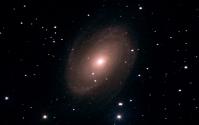Strongly Celestial Looking outward; looking backward in time... |
|||
 |
|||
iTelescope Gallery These are my pictures taken via the iTelescope network (see their website here). These are the only pictures on my website that were not taken with my own equipment. Rather, I planned, executed, and processed the images myself, but I used iTelescope's network to access their remote equipment to do the imaging itself. You can read more about my philosophy on remote astrophotography and why I am using iTelescope in the 5/8/2012 entry on my What's New page. As with all of my galleries, click on the picture itself to bring up a larger, scaleable copy of the picture in a separate window! |
||
Subject: M57 - Ring Nebula Equipment/Exposure Comments |
||||
Subject: M81 - Bode's Galaxy Equipment/Exposure Comments |
||||
Subject: M92 - Globular Cluster Equipment Comments |
||||
Subject: M39 - Open Cluster Equipment Comments This cluster is approximately 800 light years from earth and is 200-300 million years old. There are at least 30 proven stars in the cluster; note that the defraction spikes in this image were added on purpose to highlight some members. The bright central star in this image has 3.7x more mass than our sun. |
||||
Subject: M27 - Dumbbell Nebula Equipment/Exposure Comments |
||||